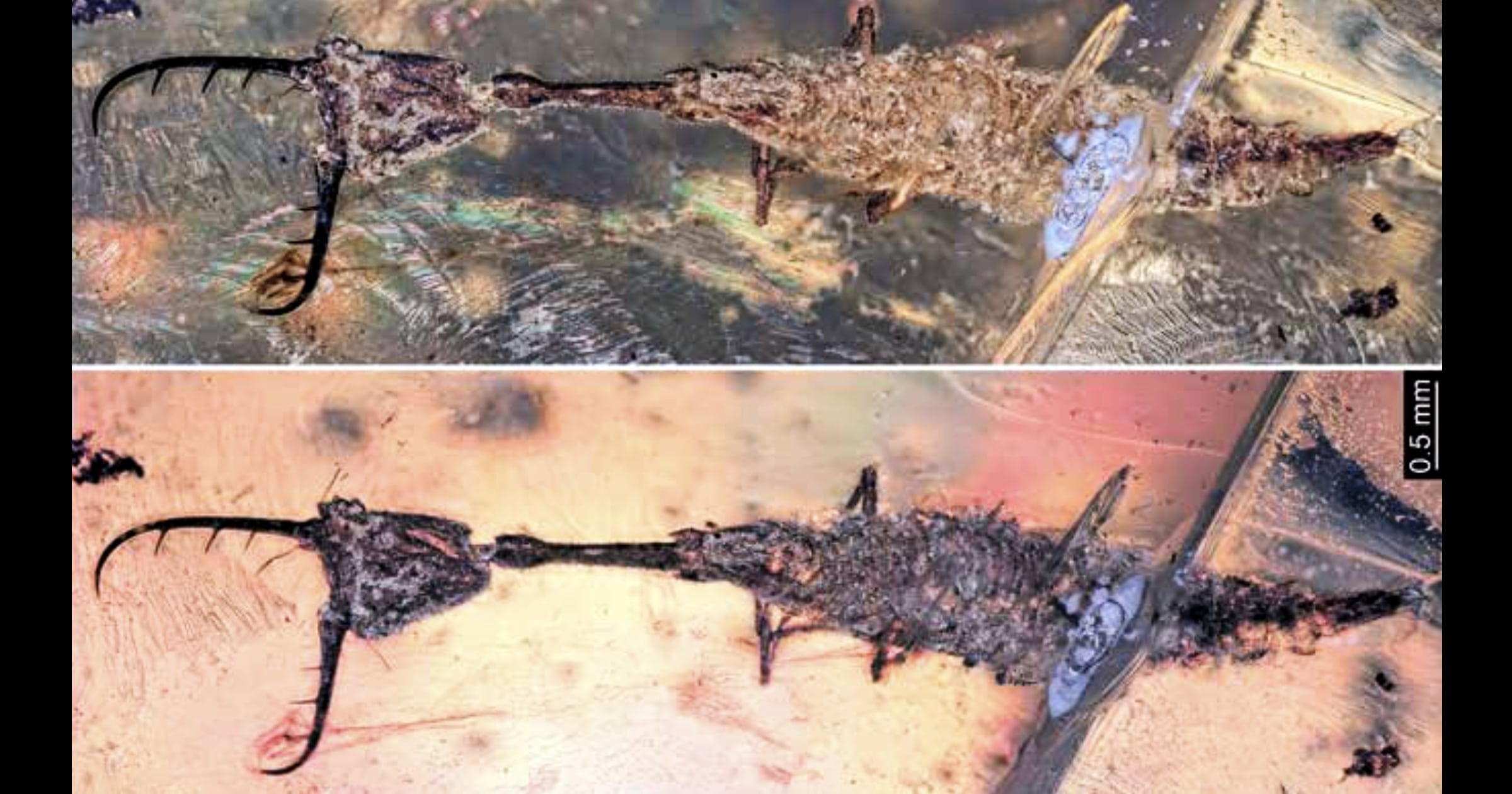 Evolution
Evolution
 Intelligent Design
Intelligent Design
 Paleontology
Paleontology
Fossil Friday: Cretaceous Insect Chimera Illustrates a Design Principle

My field of expertise and my passion are the fossil record of insects, the most diverse group of organisms on our planet. Much of my own research as a paleoentomologist has been about fossil insects from famous localities such as the Solnhofen and Crato limestones, or Baltic and Burmese amber. Therefore, I was fascinated when I read about the discovery of a new type of insects from the latter locality, which also has some implications for intelligent design. On this Fossil Friday, let’s have a look at this remarkable insect.
Insects and Other Critters
Burmese amber is a wonderful source of tens of thousands of fossil insects and other critters from the mid-Cretaceous about 100 million years ago. More than 2,500 different species have been recorded from Burmese amber (Ross 2023), and sometimes there are quite unusual forms among them. A striking example was described by my colleagues Haug et al. (2019) from the private collection of German amateur collector Patrick Müller. I had acquired some interesting amber pieces from his outstanding collection for the Natural History Museum in Stuttgart when I was still curator for this collection in the paleontology department. The new fossil was deposited in this collection. The fossil is a larva of a lacewing with a striking combination of traits. The mouth parts are developed as a pair of giant piercing-sucking stylets as in many neuropteran larvae (e.g., antlions), but are provided with three long teeth as in the larvae of owlflies (Ascalaphidae) and antlions (Myrmeleontidae). The neck is elongated in a manner otherwise known only in the larvae of thread-winged lacewings of the living family Nemopteridae (subfamily Crocinae). The trunk is slender, which is typical for larvae of aphid lions of the lacewing families Chrysopidae and Hemerobiidae.
Because of this strange mosaic combination of characters from different families, the authors called the larva a “Cretaceous chimera.” They found that “The specimen possesses a unique combination of characters unknown in any modern or fossil neuropteran larva … We must therefore conclude that the fossil species must have evolved certain characters in convergence to other lineages of Neuroptera resulting in a chimera-like morphology.”
Two years later the Haug et al. (2021) compared all the different types of long necked neuropteran larvae from living and fossil taxa. They concluded that “It remains unclear whether the fossil long-necked larvae are closely related to Crocinae. In any case these fossils represent a now extinct type of morphology, and most likely ecology.”
Implications for Intelligent Design
So, why does this fossil insect specimen have implications for intelligent design? The reason lies in the striking convergences it exhibits, which does not generally resonate well with a Darwinian picture, while it agrees perfectly with the assumption of an intelligent designer, who reuses and recombines different modules in a new construction. While Darwinism has to explain away such incongruent patterns of similarities as cases of convergent evolution, it can be more elegantly explained with an ID approach such as Winston Ewert’s dependency graph hypothesis (Hunter 2018).
Some Darwinian activists have said that if Darwinism were false and intelligent design were true then we should expect to find something like a Pegasus — that is, animals with a combination of characters from different unrelated groups (e.g., Futuyma 1985). Well, a “Cretaceous chimera” certainly qualifies. And it is not alone. I myself described a new insect order Coxoplectoptera from the Lower Cretaceous Crato Formation of northeast Brazil (Staniczek, Bechly & Godunko 2011), which we called “chimera wings.” It is an evolutionary conundrum (see Inglis-Arkell 2011) because the adults look like a chimera of dragonflies, mayflies, and praying mantids, while the larvae rather resemble gammarid shrimps. Many more such examples could be provided from modern paleontology, but they are often hidden in the technical literature and just labeled as striking cases of convergent evolution.
When I was a student at Tübingen University, I was part of a tradition and working group based on Willi Hennig’s phylogenetic systematics. At that time we still believed (and hoped) that convergence is an exception tothe rule, and thus just some insignificant noise that does not pose a major problem for phylogenetics. However, over the years numerous phylogenetic studies have accumulated overwhelming evidence for the fact that convergence represents a ubiquitous phenomenon and therefore is the rule rather than a rare exception. This is definitely the opposite of any expectations from a Darwinian point of view and to me suggests intelligent design as the better explanation of the empirical data.
References
- Futuyma DJ 1985. Evolution as Fact and Theory. Bios 56(1), 3–13. https://www.jstor.org/stable/4607934
- Haug C, Herrera-Flórez AF, Müller P & Haug JT 2019. Cretaceous chimera – an unusual 100-million-year old neuropteran larva from the “experimental phase” of insect evolution. Palaeodiversity 12(1), 1–11. DOI: https://doi.org/10.18476/pale.v12.a1
- Haug GT, Baranov V, Wizen G, Pazinato PG, Müller P, Haug C & Haug JT 2021. The morphological diversity of long-necked lacewing larvae (Neuroptera: Myrmeleontiformia). Bulletin of Geosciences 96(4), 1–27. DOI: https://doi.org/10.3140/bull.geosci.1807
- Hunter C 2018. Of Species and Software: What Is a Dependency Graph? Evolution News August 3, 2018. https://evolutionnews.org/2018/08/of-species-and-software-what-is-a-dependency-graph/
- Inglis-Arkell E 2011. This ancient insect was a chimera. Gizmodo July 19, 2011. https://gizmodo.com/this-ancient-insect-was-a-chimera-5822285
- Ross A 2013. Supplement to the Burmese (Myanmar) amber checklist and bibliography, 2022. Palaeoentomology 6(1). DOI: https://doi.org/10.11646/palaeoentomology.6.1.6
- Staniczek AH, Bechly G & Godunko RJ 2011. Coxoplectoptera, a new fossil order of Palaeoptera (Arthropoda: Insecta), with comments on the phylogeny of the stem group of mayflies (Ephemeroptera). Insect Systematics & Evolution 42(2), 101–138. DOI: https://doi.org/10.1163/187631211X578406
